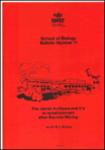The Jarrah forest avifauna and its re-establishment after bauxite mining
| dc.contributor.author | Wykes, B. | |
| dc.date.accessioned | 2017-01-30T10:34:53Z | |
| dc.date.available | 2017-01-30T10:34:53Z | |
| dc.date.created | 2008-11-12T23:21:14Z | |
| dc.date.issued | 1985 | |
| dc.identifier.citation | Wykes, B.J.. 1985. The Jarrah forest avifauna and its re-establishment after bauxite mining. : Western Australian Institute of Technology. | |
| dc.identifier.uri | http://hdl.handle.net/20.500.11937/3890 | |
| dc.description.abstract |
A two-year study of avifaunal ecology in the Jarrah forest of Western Australia was conducted in relatively undisturbed, mature forest and,for one year,in 6-year old vegetation of rehabilitated bauxite mine-pit. Avian community composition and distribution in relationship to vegetation composition was monitored and foraging observations gathered in all seasons.Changes in avian density were also compared with changes in relative abundance of insect and nectar food resources and climatic variables. The avifauna of the forest was found to be relatively depauperate in species numbers and abundances compared with communities of eastern Australian forests. Suggested reasons included geographic isolation of the S.W. forests, lack of alternative habitat for potentially migratory species during winter food minima,and specific factors such as restricted litter decomposition and absence of eucalypts with decorticating bark.Consequently, the jarrah community is of species that are widespread in southern Australian or S.W. habitats.Predictions for conservation and management of the avifauna were optimistic - most species are not restricted in distribution and those that favour habitats within the jarrah forest were not of the upland sites where bauxite is mined. The adaptable, opportunistic nature of most species are already apparent from their readiness to colonize young rehabilitation plots, withdensities and diversities of species indistinguishable from those of natural forest. However,the young rehabilitation vegetation was more similar to that of the creeks than to adjacent upland forest, as was its avian comnunity. Recommendations were made for further monitoring of rehabilitation plots since they are as yet far from mature or demonstrably viable, and for further research on some potentially endangered bird species, particularly the hollow-nesting, socially complex, frugivorous parrot races and species that are specific to the S.W. region. | |
| dc.title | The Jarrah forest avifauna and its re-establishment after bauxite mining | |
| dc.type | Report | |
| curtin.note |
Originally published as: | |
| curtin.note |
Western Australian Institute of Technology | |
| curtin.note |
Bulletin Number 11 | |
| curtin.note |
ISSN 0158 3301 | |
| curtin.department | Department of Biology (Western Australian Institute of Technology) | |
| curtin.identifier | EPR-314 | |
| curtin.accessStatus | Open access | |
| curtin.faculty | Division of Resources and Environment | |
| curtin.faculty | Muresk Institute | |
| curtin.faculty | Department of Environmental Biology |

